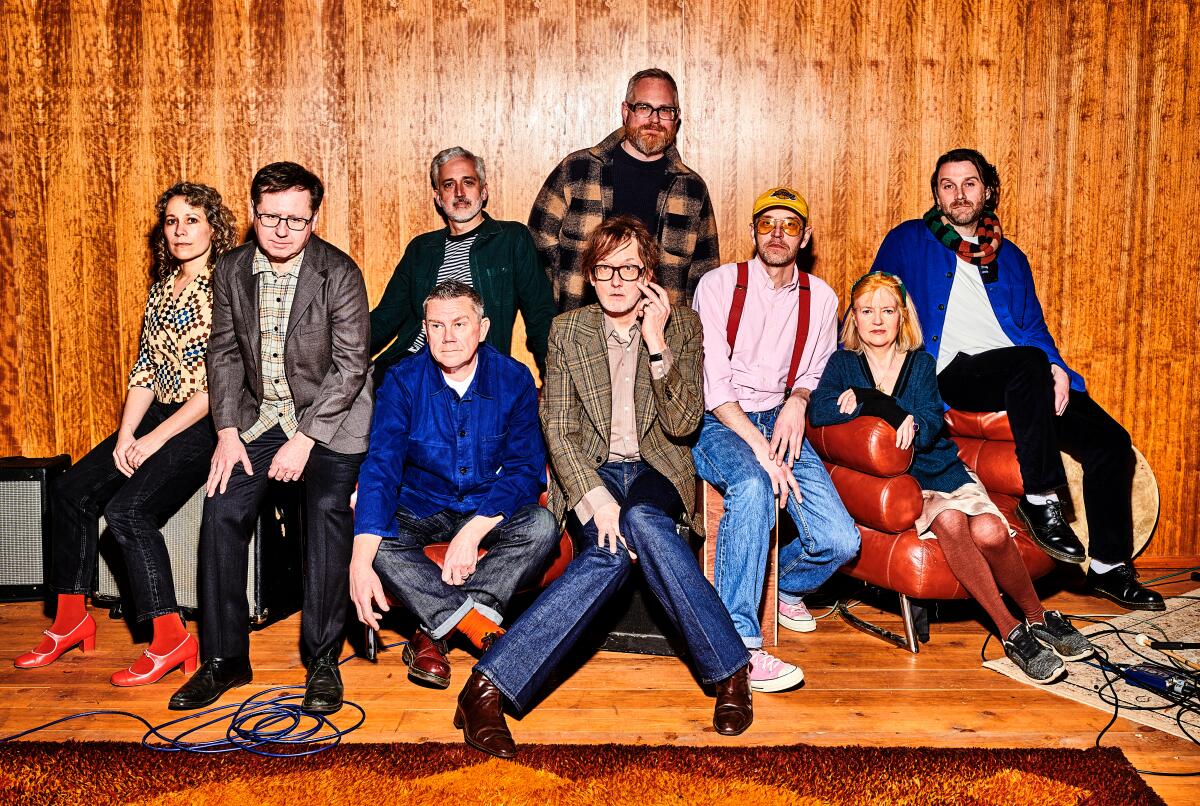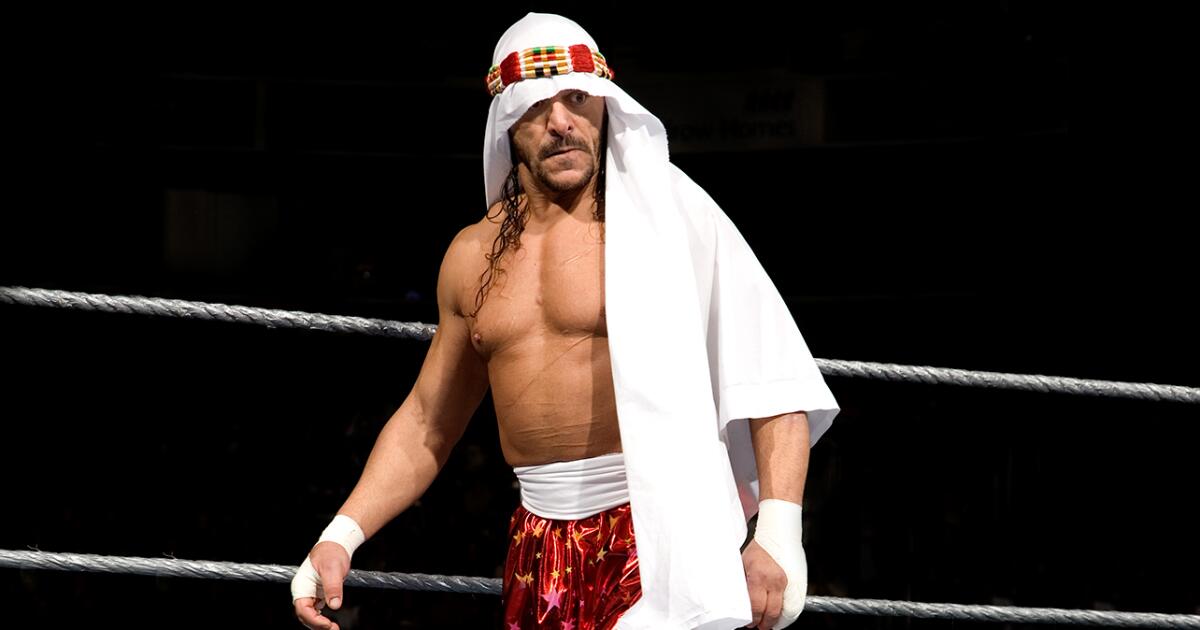Pulp nearly ceased to exist. 24 years later, ‘More’ marks its triumphant return
On a recent Friday afternoon in London, Jarvis Cocker, 62, is musing over the suit he’s just picked up from the Portobello Road Market: “I’m quite pleased with it,” he says.
He’s also grabbed some clogs — not to wear but to look at — and he notes that his wife “hates them,” but he’s happily in awe of the pair.
The outing represents a blissful break for Pulp’s leading man; it’s been a little more than two months since the group’s eighth studio effort, which debuted at No. 1 on the U.K. album charts. “More” comes more than two decades after their last project, “We Love Life,” released in 2001.
“I’ve come to realize over 24 years that I enjoy making music,” Cocker says. “It’s a main source of enjoyment. I mean, I enjoy being with my wife and stuff like that. But in terms of creativity, it’s my favorite thing to do.”
When Cocker first started making music — around “15 or 16” — he saw forming a band as a way for him to “navigate the world at a safe distance.”
“I was always quite a shy kid, so it was difficult for me to talk to people,” he recalls. “To talk to people from a stage, rather than to their faces… that worked to a certain extent.”

Though generally considered the “underdogs” of Britpop, Pulp produced some of the most intriguing sounds of the ’90s.
(Tom Jackson)
But the band’s early attempts to make the grade had fallen flat on its face. Unlike some of the group’s Britpop peers, Pulp had been around since the ’80s — Blur, Oasis, and Suede all released their debuts in the first half of the ’90s.
“It” came out as a mini-LP of sorts, under Red Rhino Records, with a short 31-minute run time over eight tracks.
“It was a deafening silence,” Cocker says of its reception. “It really didn’t sell anything at all … We played a few concerts, and then the band fell apart.”
He adds that at that point, he was considering giving up music, shipping off to Liverpool and studying English. He’d been offered entry into a program there, but two months before he was due to start, he got a call from Russell Senior.
“[He] asked me what I was doing, and I said, ‘Oh, I’m giving up music, it’s not working out’” he says. “We had a rehearsal just him, me, and Magnus Doyle [brother of Candida Doyle, Pulp’s eventual keyboardist], and it was exciting.”
Notably, he remembers thinking, “I don’t want to go read English. I’m going to stay in Sheffield and see what happens.”
Though the group would inch closer to what we now know as Pulp’s lineup, the musicians faced similar problems: They “didn’t sell anything” and were “quite ignored.” In fact, it wasn’t until Cocker went off to college to study filmmaking at Central Saint Martins — taking a sabbatical from Pulp and then returning in 1991 — that the band was asked to play a concert in ’92 and gained some traction.
Later that year, Britpop fame followed, as they were asked to play a Parisian festival alongside some would-be familiar faces: Blur and Lush.
“It was like we had some friends at last,” he jokes.
A historic run of releases came in the following decade, with “His ‘n’ Hers,” “Different Class” and “This Is Hardcore” all concocted in a period of four years.
“Having been a real … wilderness for a long time, and feeling very out on a limb … to be considered part of a movement, at least at first, was exciting,” he recalls.
“Once we actually got a chance to become popular, especially after ‘Common People’ had been a hit … then we had to record ‘Different Class’ very quickly to kind of capitalize on that.”
But the grind began to slow down to a halt. He confesses that after Pulp released “This Is Hardcore” in 1998, he began contemplating whether he “should still be in a band.” In the face of growing popularity, Cocker’s image became more well known, and the lens began to close in.
“It just put me into a different kind of social situation that I didn’t really enjoy,” he remembers. “So, I was conflicted.”
Around 2002 — one year after the release of “We Love Life” — the group quietly disbanded. In the more than two decades in between, Cocker positioned himself as a bit of a renaissance man, while pulling away from the Pulp lifestyle and delving into a solo career.
He waded into broadcast media, serving as a host on BBC Radio 6 Music’s “Jarvis Cocker’s Sunday Service,” wrote a memoir titled “Mother, Brother, Lover,” and made a cameo in “Harry Potter and the Goblet of Fire” in 2005 as part of the fictional band the Weird Sisters. His bandmates? Jonny Greenwood, Jason Buckle and Pulp bass guitarist Steve Mackey.
“I have written a book, and I presented radio shows, and I enjoy those. But music, to me … it’s a way of me making sense of what has happened to me in my life,” he says. “I write about things that have happened, and I, in a way, dramatize them by putting music to it.”
“I fell in love with music at a very early age, and so it feels like a magical thing to be able to make something that you like so much,” he adds.
In this lengthy love affair with music, it was inevitable that he would return to his first love: Pulp.

“More” returns to the band’s sonic roots, with thoughtful tunes such as “Grown Ups” and “A Sunset.”
(Tom Jackson)
When the band began working on “More,” Cocker’s main concern was that his bandmates would have thought they were “being sentenced to three years’ jail time.”
“I was loath to say to the band, ‘Let’s make an album,’ just because the last two Pulp albums that we’ve done, ‘This Is Hardcore’ and ‘We Love Life,’ had taken so long to record,” he explains.
For further context, “This is Hardcore” took around three years to record. “More” would only take three weeks and was released on June 6.
“There were songs that I knew could be good, but we’d never managed to realize them properly,” he says. “And then there were newer songs, and some songs that I’d done that I tried to play in the band, “Jarvis,” but hadn’t quite worked out.”
“The thing that makes a song good … You can’t control it, and sometimes it works easily, and sometimes it doesn’t work at all … we were just lucky, maybe because we’d left it for a long time.”
He also credits the album’s swift completion to working with music producer James Ford, who previously refined tracks for a seemingly endless list of artists. Some recent highlights include Blur’s “The Ballad of Darren,” Fontaines D.C.’s “Romance” and “Forever, Howlong,” by Black Country, New Road.
“He created a really good environment for us to record in, and everybody felt quite relaxed,” Cocker says. “It seemed like it was ready. So, it was just, ‘OK, it’s ripe. Just pick it from the tree and eat it.’”
Fresh off the June release, Cocker also kick-started a tour with dates across the U.K. and Ireland. In September, he landed in Atlanta for its North American leg, which features two shows in Los Angeles.
In particular, these stand out because Pulp will play alongside LCD Soundsystem at the Hollywood Bowl on Thursday and Friday. Simply put, Murphy said, “We’re playing at the Hollywood Bowl, would you like to come play with us?” — to which Cocker replied, “That would be good.”
It’s all been going relatively swimmingly for him, who simply sticks to his ways. But who is Jarvis Cocker in 2025?
He pauses a moment before speaking.
“It’s hard to put it into words, but I came to the realization that I wanted to live, or attempt to live, more in a world of feelings than in a world of ideas,” he says, thoughtfully. “So yeah, that’s my experiment at the moment. I’ll let you know how it goes.”




